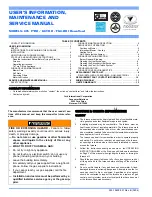
507404-02
Page 25 of 80
Issue 1448
General Guidelines for Vent Terminations
In Non–Direct Vent applications, combustion air is taken
from indoors and the flue gases are discharged to the
outdoors. This furnace is then classified as a non–direct
vent, Category IV gas furnace.
In Direct Vent applications, combustion air is taken from
outdoors and the flue gases are discharged to the outdoors.
The furnace is then classified as a direct vent, Category IV
gas furnace.
In both Non–Direct Vent and Direct Vent applications, the
vent termination is limited by local building codes. In the
absence of local codes, refer to the current National Fuel
Gas Code ANSI Z223-1/NFPA 54 in U.S.A., and current
CSA-B149 Natural Gas and Propane Installation Codes in
Canada for details.
In Direct Vent applications, the vent termination is limited by
local building codes. In the absence of local codes, refer to
the current National Fuel Gas Code ANSI Z223-1/NFPA 54
in U.S.A., and current CSA-B149 Natural Gas and Propane
Installation Codes in Canada for details.
Follow the next two steps when installing the unit in
Non–
Direct Vent applications
where combustion air is taken
from indoors and flue gases are discharged outdoors
.
1.
Use field-provided materials and the factory-provided
air intake screen to route the intake piping as shown in
Figures 27 or 28. Maintain a minimum clearance of 3”
(76 mm) around the air intake opening. The air intake
opening (with the protective screen) should always be
directed forward or to either side in the upflow position,
and either straight out or downward in the horizontal
position.
The air intake piping must not terminate too close
to the flooring or a platform. Ensure that the intake
air inlet will not be obstructed by loose insulation
or other items that may clog the debris screen.
2. If intake air is drawn from a ventilated attic (Figure 28)
or ventilated crawlspace (Figure 30) the exhaust vent
length must not exceed those listed in Table 5C. If 3”
diameter pipe is used, reduce to 2” diameter pipe ar the
termination point to accommodate the debris screen.
3. Use a sheet metal screw to secure the intake pipe to
the connector, if desired.
If this unit is being installed in an application with
combustion air coming in from a space serviced by an
exhaust fan, power exhaust fan, or other device which
may create a negative pressure in the space, take care
when sizing the inlet air opening. The inlet air opening
must be sized to accommodate the maximum volume
of exhaust air as well as the maximum volume of
combustion air required for all gas appliances serviced
by this space.
CAUTION
Figure 29
Figure 30
Summary of Contents for A96US2V
Page 3: ...507404 02 Page 3 of 80 Issue 1448 EXPANDED VIEW Figure 1 ...
Page 31: ...507404 02 Page 31 of 80 Issue 1448 Figure 38 ...
Page 38: ...507404 02 Page 38 of 80 Issue 1448 Figure 56 TRAP DRAIN ASSEMBLY USING 1 2 PVC or 3 4 PVC ...
Page 41: ...507404 02 Page 41 of 80 Issue 1448 Table 9 ...
Page 45: ...507404 02 Page 45 of 80 Issue 1448 ...
Page 47: ...507404 02 Page 47 of 80 Issue 1448 Integrated Control Figure 56 ...
Page 78: ...507404 02 Page 78 of 80 Issue 1448 Start Up Performance Check List UNIT SET UP ...
Page 79: ...507404 02 Page 79 of 80 Issue 1448 UNIT OPERATION Heating Mode Cooling Mode ...
















































